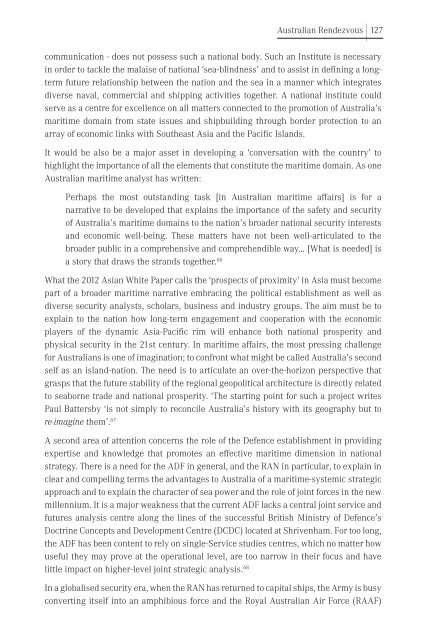THE FUTURE OF SEA POWER
SPC2015_Proceedings
SPC2015_Proceedings
You also want an ePaper? Increase the reach of your titles
YUMPU automatically turns print PDFs into web optimized ePapers that Google loves.
Australian Rendezvous |<br />
127<br />
communication - does not possess such a national body. Such an Institute is necessary<br />
in order to tackle the malaise of national ‘sea-blindness’ and to assist in defining a longterm<br />
future relationship between the nation and the sea in a manner which integrates<br />
diverse naval, commercial and shipping activities together. A national institute could<br />
serve as a centre for excellence on all matters connected to the promotion of Australia’s<br />
maritime domain from state issues and shipbuilding through border protection to an<br />
array of economic links with Southeast Asia and the Pacific Islands.<br />
It would be also be a major asset in developing a ‘conversation with the country’ to<br />
highlight the importance of all the elements that constitute the maritime domain. As one<br />
Australian maritime analyst has written:<br />
Perhaps the most outstanding task [in Australian maritime affairs] is for a<br />
narrative to be developed that explains the importance of the safety and security<br />
of Australia’s maritime domains to the nation’s broader national security interests<br />
and economic well-being. These matters have not been well-articulated to the<br />
broader public in a comprehensive and comprehendible way... [What is needed] is<br />
a story that draws the strands together. 66<br />
What the 2012 Asian White Paper calls the ‘prospects of proximity’ in Asia must become<br />
part of a broader maritime narrative embracing the political establishment as well as<br />
diverse security analysts, scholars, business and industry groups. The aim must be to<br />
explain to the nation how long-term engagement and cooperation with the economic<br />
players of the dynamic Asia-Pacific rim will enhance both national prosperity and<br />
physical security in the 21st century. In maritime affairs, the most pressing challenge<br />
for Australians is one of imagination; to confront what might be called Australia’s second<br />
self as an island-nation. The need is to articulate an over-the-horizon perspective that<br />
grasps that the future stability of the regional geopolitical architecture is directly related<br />
to seaborne trade and national prosperity. ‘The starting point for such a project writes<br />
Paul Battersby ‘is not simply to reconcile Australia’s history with its geography but to<br />
re-imagine them’. 67<br />
A second area of attention concerns the role of the Defence establishment in providing<br />
expertise and knowledge that promotes an effective maritime dimension in national<br />
strategy. There is a need for the ADF in general, and the RAN in particular, to explain in<br />
clear and compelling terms the advantages to Australia of a maritime-systemic strategic<br />
approach and to explain the character of sea power and the role of joint forces in the new<br />
millennium. It is a major weakness that the current ADF lacks a central joint service and<br />
futures analysis centre along the lines of the successful British Ministry of Defence’s<br />
Doctrine Concepts and Development Centre (DCDC) located at Shrivenham. For too long,<br />
the ADF has been content to rely on single-Service studies centres, which no matter how<br />
useful they may prove at the operational level, are too narrow in their focus and have<br />
little impact on higher-level joint strategic analysis. 68<br />
In a globalised security era, when the RAN has returned to capital ships, the Army is busy<br />
converting itself into an amphibious force and the Royal Australian Air Force (RAAF)


